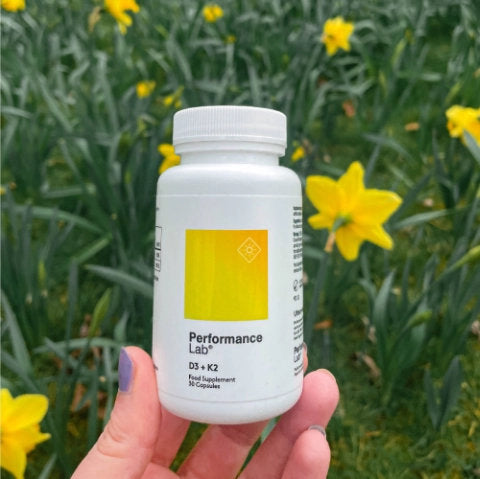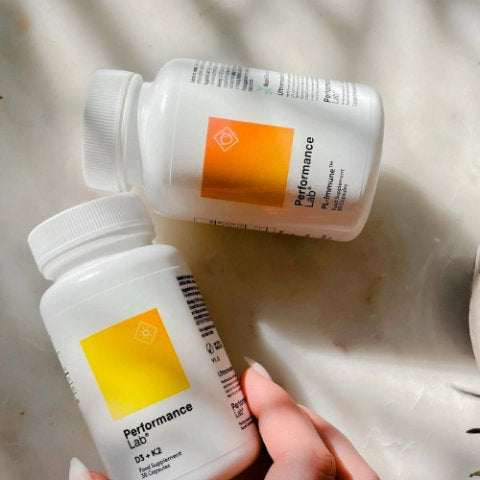The immune system is a complex system scattered throughout your body that serves to protect your body in every way possible.
Whether it’s a cut on your skin, a viral invader coming to spread the flu, or an intense workout that left you achy and inflamed, the immune system swoops in to help repair and recover and get you back on your feet.
But while most people know their immune system keeps them healthy, they’re unaware of what happens in the immune system. It’s comprised of two different branches—the innate immune system and the adaptive immune system—that have different roles in protecting the body.
If you weren’t aware of the different kinds of systems your body has, this article is for you. We’re covering the immune system basics and giving you everything you need to know about the difference between innate and adaptive immunity.
Basics Of The Immune System
The immune system is one of the most powerful systems in your body, designed to fight infections and maintain health. Most people don’t notice it’s even there if the immune system operates well.
But you get sick when things stop working properly—either because of a weakened immune system or a particularly aggressive pathogen. For the most part, these germs are ones you’ve never encountered, and your body hasn’t built up a system to deal with them(this is your innate immune system reacting).
While most people think of the immune system as one extensive system, it’s comprised of smaller ones, specifically the adaptive and innate immune systems; the former is regarded as the general or non-specific system, while the latter is the specific or learned system. Both the innate and adaptive immune systems work closely together on various tasks.
The non-specific or innate immune system generally protects the body against pathogens, injuries, and foreign bodies that threaten homeostasis 1; it is the body’s first line of defense when something enters.
On the other hand, the specific or adaptive immune system triggers a reaction against particular pathogens or changed body cells; these reactions are often to cells or compounds the body has come into contact with before, hence the name “adaptive.”
Before we dive into the details of the innate and adaptive immune systems, let’s get a refresher on what the immune system is and what it’s made up of.
The immune system comprises various organs, cells, and proteins designed to protect the body from invaders. Its primary tasks are to 2:
- Fight pathogens like bacteria, viruses, parasites, or fungi, and eliminate them from the body
- Recognize and neutralize harmful environmental substances
- Fight disease-causing changes in the body like cancerous cell growth
Typically we think about bacteria or viruses activating the immune system—but it can be triggered by anything it doesn’t recognize as its own (i.e. antigens).
These can be proteins on the surfaces of viruses, bacteria, or fungi that attach to specific receptors on the immune cells and trigger a response 2.
After the first contact with a disease-causing germ, the body will store information about the germ and how to fight it; this is called immunological memory. It can mount an immune response faster if it comes into contact with it again.
The body’s cells also have proteins on their surface, but these don’t typically trigger immune responses. However, sometimes the immune system can mistake its cells for foreign cells and mount an immune response against them. If this is the case, an autoimmune response occurs.
Immune System Components
With all of that said, what makes up the immune system? As the said, the immune system is comprised of various organs, tissues, and proteins that protect the body against invaders:
- White blood cells
- Antibodies
- Complement system
- Lymphatic system
- Spleen
- Thymus
- Bone marrow
All immune system cells originate in bone marrow, many of which also mature before they migrate to specific tissues, enter the bloodstream, or travel to lymphatic system vessels 3.
Also, remember that apart from the interior components of the immune system, several physical barriers protect the body from invaders.
These include the skin, cornea, (eyes), and mucosal barriers of the respiratory, gastrointestinal, and genitourinary tracts; these form the first line of defense against invaders. But some of these physical barriers also have active immune functions:
- Outer epidermis: Keratinocytes in the skin release antimicrobial peptides called defensins; sebaceous and sweat glands release microbe-inhibiting compounds like lactic acid and fatty acids; several immune cells like mast cells and antigen-sampling Langerhans cells reside in the skin to fight pathogens.
- Cornea: Neutrophils migrate to the cornea and function to kill microbes via phagocytosis.
- The mucosa of the respiratory, GI, and genitourinary tracts: Mucous within these tracts contain antimicrobial substances (lysozyme, lactoferrin, secretory immunoglobulin (Ig) A antibody (SIgA)) that protect the body against invaders.
Once something breaches any of these barriers, it will trigger one of two responses:
- Innate
- Adaptive (acquired)
These responses are what we refer to as innate and adaptive immunity.
Innate Immune System
There are two subdivisions of the immune system known as the innate immune system (non-specific) and the adaptive immune system (specific).
These subsystems are closely aligned and work together to neutralize and eliminate harmful substances that trigger an immune system.
The innate immune system is the body’s first line of defense against invading pathogens 1; it responds similarly against all foreign substances, which is why it’s termed the “non-specific” immune system.
The innate immune system is fast-acting and detects and destroys invading cells within hours of breaching a physical barrier. It consists of:
- Skin and mucous membranes
- Immune system cells (defense cells) and proteins
The innate immune system fights primarily using immune cells like natural killer cells and phagocytes. If a pathogen breaches the skin, it also triggers a local inflammatory response that consists of scavenger cells and proteins (enzymes) to neutralize the harmful compounds.
Pathogens that enter the body are stopped immediately by scavenger cells, also known as phagocytes; these are specialized types of white blood cells that engulf and destroy germs.
The remains of these germs migrate to the surface of phagocytes so the adaptive immune system can detect them upon subsequent exposure.
Several other immune cells also release substances that kill pathogens. When germs and body tissues die during an immune response, their remnants form a yellowish fluid called pus.
Proteins also have a significant role in the innate immune response. Nine different enzymes activate one another to form a chain reaction; one enzyme is activated in the first stage, which activates another in the second stage, and so on. This allows the immune response to escalate rapidly. The role of these enzymes include 1:
- Mark germs as targets for phagocytes and other scavenger cells
- Attract other immune system cells from the bloodstream to the site of infection
- Destroy bacteria by dissolving their cell walls
- Fight viruses by destroying the viral envelope (the outer layer) or cells infected with viruses
The last type of cell activated during the innate immune response is the natural killer cells, also known as NK cells. These cells specialize in identifying virus-infected cells or tumorous cells by searching for cells that have altered surfaced. Once found, they destroy them using cellular toxins.
Key takeaway: The innate immune system is the body’s first line of defense against invading pathogens; innate immunity is non-specific and responds similarly to all foreign substances. It consists of the skin and mucous membranes, various immune system cells (defense cells), and proteins.
Remember, innate immune responses are fast!
The Adaptive Immune System
The other subsystem of the immune system is the adaptive immune system, sometimes called acquired immunity—it takes over when the innate system can’t easily destroy pathogens and targets specific cells that cause the infection.
However, before it can laser-focus on a specific cell type, it first has to identify the germs for destruction. It’s typically slower than the innate responses, but it has greater accuracy 1.
This immunological memory is why some illnesses can only be caught once; once the adaptive immune system recognizes a pathogen, it can mount a response much quicker.
Several different cell types make up the adaptive immune system and differ from the innate immune system. The adaptive immune cells include:
- T lymphocytes (T-cells)
- B lymphocytes (B-cells)
- Antibodies (located in the blood and other body fluids)
T-cells are produced in the bone marrow and migrate to the thymus. Their three main jobs include activating other immune cells to trigger the adaptive immune system, detecting infected cells and destroying them (cytotoxic T cells), and producing memory T-cells that can “remember” germs to initiate quick activation of the adaptive immune system upon subsequent infection 1.
T-cells have features on their surface that attach to germ cells and generate matching T-cells that multiply to fight that specific germ.
B-cells are produced in the bone marrow and mature into specialized immune cells 1. As with T-cells, specific types of B-cells match particular germs.
These cells are activated by T-helper cells that match the same germs; they are activated and transform into plasma cells, producing large amounts of antibodies released into the blood.
Because only the B-cells matching the germs are activated, only the specific antibodies needed to fight the pathogen will be produced. However, some activated B-cells will transform into memory cells and become part of the ‘memory’ of the adaptive immune system.
Lastly, antibodies are compounds that circulate in the bloodstream to fight foreign invaders. They can rapidly detect germs and other harmful substances by detecting and attaching to them to neutralize the invader; they also recruit other immune cells for help.
B-cells produce antibodies in response to invasion by a germ; substances that trigger the production of antibodies are called “antigens.” An antibody can only attach to an antigen if it’s an exact match; think of it like a lock and key—it has to fit to a tee to work. In general, antibodies have three functions:
Neutralize germs by attaching to their cell surface or attaching to their toxinsActivate and recruit other immune system cells by sticking to their surfaceActivate proteins that support the immune system response
Key takeaway: The adaptive immune system is a specific or acquired immune response that develops after initial exposure to a germ. T lymphocytes, B lymphocytes, and antibodies work together to neutralize and destroy pathogens after initial exposure rapidly.
5 Tips To Strengthen Your Immune System Naturally
The immune system is complicated, and while it’s inherent to all humans, you must take care of it to ensure it functions optimally.
Bolstering your immune system is much easier said than done, but several dietary and lifestyle changes can strengthen and support immune function. Here are some easy tips to support your immunity naturally:
1. Get enough sleep
Aim for 7-9 hours of good quality sleep per night. Sufficient sleep strengthens your immunity and reduces the risk of catching a cold 4, 5.
2. Eat more plants
Whole foods are rich in phytonutrients and antioxidants, allowing your body to fend off invaders more efficiently. Antioxidants help to reduce inflammation, while fiber supports a healthy and more robust gut microbiome 6, 7.
3. Load up on fermented foods
With more than 70% of your immune system residing in your gut, good gut health is a must—and probiotic-rich fermented foods help to repopulate and allow the beneficial bacteria in the gut to proliferate and thrive.
4. Limit sugar
Sugar kills gut bacteria and contributes to inflammation and disease development. Swap out traditional white sugar for naturally-sweetened foods or eliminate sugar altogether.
5. Supplement wisely
Your immune system requires specific nutrients for optimal function—vitamin C, vitamin D, zinc, and selenium. Supplementation is necessary to maintain proper immune function if you’re not getting enough through food.
Instead of loading up on single nutrients, cover your bases with Performance Lab PL-Immune and NutriGenesis Multi.

They’re the ultimate duo to bolster immune responses and overall health and well-being with targeted nutrients specific to your needs. Both supplements contain bioidentical vitamins and minerals for maximum absorption and benefit.
That way, you don’t have to stress whether your immune needs are being met—PL-Immune and Multi have your back.
References
- InformedHealth.org . Cologne, Germany: Institute for Quality and Efficiency in Health Care (IQWiG); 2006-. The innate and adaptive immune systems. . Available from: https://www.ncbi.nlm.nih.gov/books/NBK279396/
- InformedHealth.org . Cologne, Germany: Institute for Quality and Efficiency in Health Care (IQWiG); 2006-. How does the immune system work? . Available from: https://www.ncbi.nlm.nih.gov/books/NBK279364/
- Janeway CA Jr, Travers P, Walport M, et al. Immunobiology: The Immune System in Health and Disease. 5th edition. New York: Garland Science; 2001. The components of the immune system. Available from: https://www.ncbi.nlm.nih.gov/books/NBK27092/
- Prather AA, Janicki-Deverts D, Hall MH, Cohen S. Behaviorally Assessed Sleep and Susceptibility to the Common Cold. Sleep. 2015;38(9):1353-1359.
- Besedovsky L, Lange T, Haack M. The Sleep-Immune Crosstalk in Health and Disease. Physiol Rev. 2019;99(3):1325-1380.
- Serafini M, Peluso I. Functional Foods for Health: The Interrelated Antioxidant and Anti-Inflammatory Role of Fruits, Vegetables, Herbs, Spices and Cocoa in Humans. Curr Pharm Des. 2016;22(44):6701-6715.
- Holscher HD. Dietary fiber and prebiotics and the gastrointestinal microbiota. Gut Microbes. 2017;8(2):172-184.














